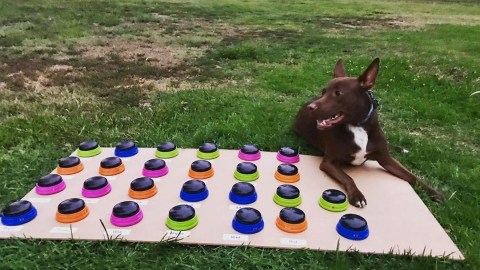Meet Stella — the pup who knows how to use 29 human words

- A speech language pathologist has taught her puppy Stella to use 29 words.
- Stella “speaks” by stepping on large buttons programmed with recordings of words.
- The dog expresses her desires, comments on household events, and offers opinions.
It’s obvious that dogs have the capacity to understand human words. The family canine’s response to “out,” “walk,” or “car” is both helpful and entertaining for a human, and a source of significant excitement for a pooch. Each owner or family teaches its dog a vocabulary their pet agreeably learns, with the exception of “no” and “bad,” of course. So if dogs can understand our words, what kind of communication would be possible if they were able to voice them as well?
Speech language pathologist (SLP) Christina Hunger uses Augmentative and Alternative Communication (AAC) devices in her job and decided to see if one could give her dog Stella a chance to use her words. The results of her experiment are amazing.
Stella’s vocabulary is up now to 29 words, and she can fluidly string them together to express her desires and her feelings.
A speech language pathologist’s idea
Hunger has a blog explaining what’s going on with Stella, who’s an 18-month-old Catahoula/Blue Heeler mix. The blog is called Hunger for Words. Her experiment was inspired by a quotation of Rosemary Crossley’s:
“Not being able to speak is not the same as not having anything to say.”
Hunger explains that every human has two sorts of language capacities. First is receptive language, the ability to understand the meanings of words and sentences we hear. Dogs as noted above, clearly have receptive language.
Expressive language is how we communicate to others using words and sentences, written words, gestures, and facial expressions. Dogs regularly express themselves by barking, growling, with speech-like moaning, sighing, and of course, jumping in excitement. Hunger considers these all to be expressive language, canine-style, which suggests that they share our desire to communicate.
For the mechanics of helping Stella use human words for expressing herself without a human vocal apparatus, Hunger turned to AAC technology as a pathway forward.
AAC devices are computer-based instruments that present symbols for words as big, touchable buttons. When a button is touched, the associated word sounds. Speech-challenged children learn to trigger the words they want the machine to say for them, put them together in sentences, and allow them to begin to, as Hunger says, “experience the power of language.”
Stella’s language lessons
To get started with Stella, Hunger and her fiancé Jake programmed a single button on a simple speech sound board. A press of the button plays back the word “outside,” a concept right in a dog’s wheelhouse. Hunger recalls, “Every time we took Stella outside we pushed ‘outside’ before opening the door. After a few weeks of modeling, Stella showed us she was aware of what was happening. When I would ask, ‘Outside? Stella, want to go outside?’ she began looking down at the button, looking up at me, and barking. As an SLP I knew this was a huge step in the right direction.” Soon Stella was pressing the button herself when she wanted to be go out.
Other buttons were quickly programmed either with words the couple frequently used with Stella, or things they thought she herself might want to communicate, such as “eat, water, play, walk, no, come, help, bye, love you.” The results were startling:
“If Jake and I were distracted, Stella began saying ‘play’ repeatedly until we threw her toy or engaged in tug of war. Stella would walk to her water bowl, notice it was empty and say ‘water.’ If we had finished dinner and didn’t mention going for a walk yet, Stella would say ‘walk’ multiple times while staring at us. If her toy was stuck under the couch, she would say ‘help’ and stand right where she needed Jake or I to look. When our friends were putting their jackets on or were standing by the door, she would say ‘bye’ to them. Jake and I were simply amazed.”
As time went by, says Hunger, Stella began using language in a manner similar to the way we do. (She’s been learning words since last January.) Not restricting words’ use to her needs, she began providing commentary: “This first happened when I was watering my plants. Stella said “water” while watching me, even though her water dish was full.”
Most exciting is that Stella now puts words together for more complex communication, including reprimands for her humans. For example, animals couldn’t care less about our clock adjustments in the fall and spring. “One afternoon,” recalls Hunger, “shortly after the Daylight Savings time change, Stella said, ‘eat’ repeatedly at about 3:00 PM. When Jake and I did not feed her dinner this early she said, ‘love you no’ and walked into the other room.”
Another example: The time she pressed “Want,” “Jake,” Come,” and planted herself by the door. Upon Jake’s eventual return, she hit the “Happy” button and rolled over for a tummy rub.
Trailblazing Stella
We’ve seen examples, most notably gorilla Koko, of animals who’ve acquired the ability to communicate using human words, and dog owners would hardly doubt their own dog’s affinity for receptive language — expressive language doesn’t seem like that much of a leap. In addition, scientists consider average dog intelligence to be roughly similar to a human two-year-old’s, and that’s right about the time toddlers start talking.
You can keep up with Stella’s progress, and Hunger’s SLP-expert insights, on Hunger’s blog and on Instagram.





